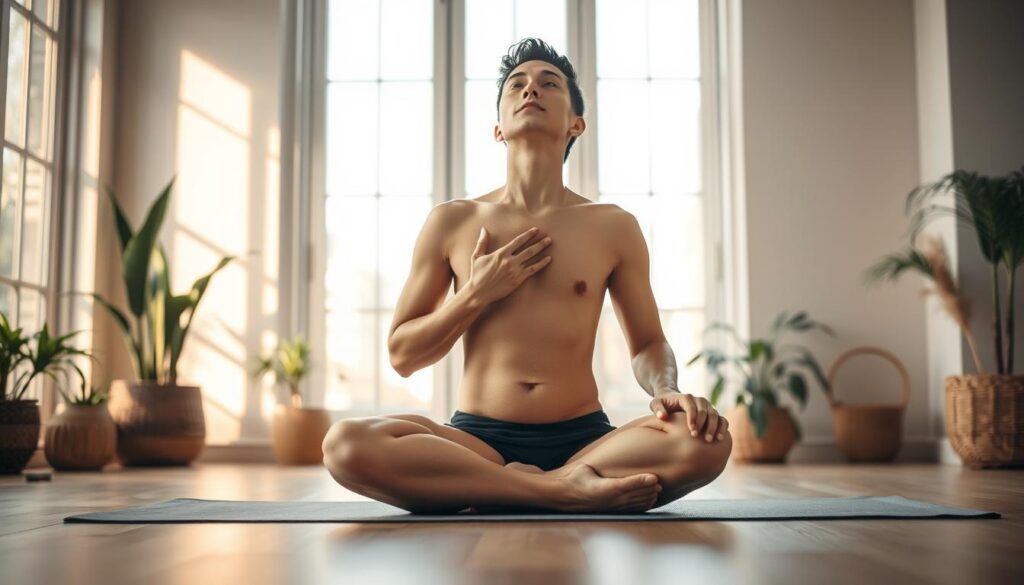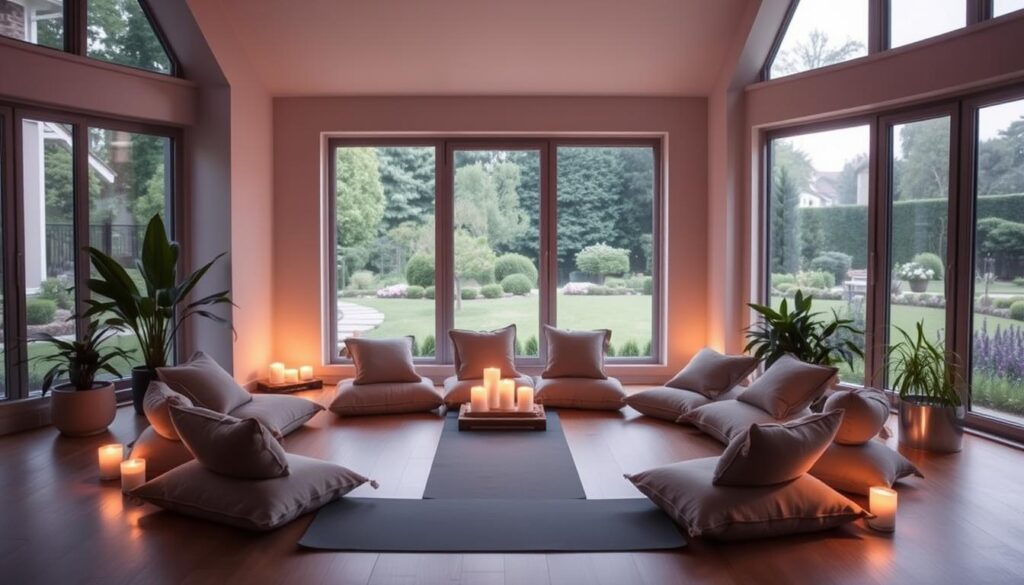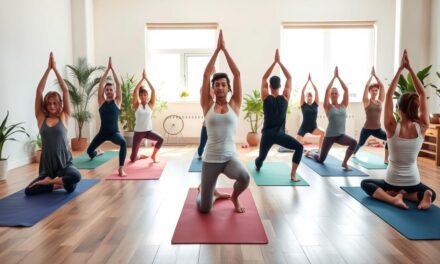Can changing how we breathe really help us relax and reduce stress? Many people are curious about this. They want to know if deep breathing exercises can help manage stress. Breathing techniques are known to help us relax and lower stress levels.
By adding breathing techniques to our daily routine, we can feel better overall. This simple change can make a big difference in our well-being.
Effective breathing techniques can calm our minds and bodies. They are key to any stress relief plan. With the right breathing techniques, we can instantly relax and lower our stress levels.
Breathing techniques are a simple yet powerful way to manage stress. They help us relax and feel better.
Introduction to Breathing Techniques for Stress Relief
Deep breathing exercises are great for reducing stress and promoting relaxation. By learning and practicing different breathing techniques, we can achieve a more balanced state. These techniques can be used anywhere, anytime, making them easy to access for stress management.
Key Takeaways
- Breathing techniques can provide instant stress relief and relaxation
- Deep breathing exercises are a simple yet effective method for managing stress
- Breathing techniques can be used to calm the mind and body
- Regular practice of breathing techniques can lead to significant improvements in overall well-being
- Breathing techniques are a convenient and accessible method for managing stress
Understanding the Science Behind Breathing Techniques
Managing stress is easier with breathing techniques. The autonomic nervous system controls things like heart rate and blood pressure. It’s linked to how we breathe. By doing mindfulness breathing, we can calm our nervous system and lower stress.
Using the right breathing, like diaphragmatic breathing, boosts both body and mind health. Guided breathing sessions help us notice our breath better. This lets us handle stress and anxiety better. Here are some key benefits:
- Reduced stress and anxiety
- Improved sleep quality
- Increased oxygenation of the body
- Enhanced mental clarity and focus
Adding mindfulness breathing and diaphragmatic breathing to our daily routine helps a lot. Whether it’s through guided breathing sessions or on our own, the science shows: right breathing is key to health.
The Autonomic Nervous System and Breathing
The autonomic nervous system controls things like heart rate and breathing. By doing mindfulness breathing and diaphragmatic breathing, we can calm our nervous system. This lowers stress and boosts health.
How Proper Breathing Affects Stress Levels
Techniques like diaphragmatic breathing and guided breathing sessions really help with stress. They reduce anxiety and improve health and well-being.
The Mind-Body Connection in Breathing
Our breathing is closely tied to our mind and body. By practicing mindfulness breathing and diaphragmatic breathing, we become more aware of our breath. This deepens our understanding of the mind-body connection and improves health.
| Breathing Technique | Benefits |
|---|---|
| Mindfulness Breathing | Reduced stress and anxiety, improved sleep quality |
| Diaphragmatic Breathing | Increased oxygenation of the body, enhanced mental clarity and focus |
| Guided Breathing Sessions | Improved mental clarity and focus, reduced stress and anxiety |
Essential Elements of Effective Breathing Practice
Creating a good environment is key for controlled breathing methods. Find a quiet, comfy spot to practice without distractions. This lets you dive deep into your relaxation breathing techniques.
Good posture is vital for effective breathing. It helps you breathe deeper and better. Paying attention to your breathing rate and focus also boosts the experience. Intentional breathing practices like these can help you relax and lower stress.
Important things to think about for a breathing practice include:
- Creating a peaceful and calming atmosphere
- Establishing a consistent practice schedule
- Focusing on proper posture and breathing technique
By adding these elements, you can better understand controlled breathing methods and relaxation breathing techniques. This makes your breathing practice more effective and helpful.
Embracing intentional breathing practices daily can greatly reduce stress and anxiety. This leads to better overall well-being.
The Box Breathing Method for Immediate Calm
The box breathing method is a simple yet effective way to reduce stress and anxiety. It involves breathing in for a count of four, then holding your breath for four counts. Next, exhale for four counts, and hold again for four counts. This creates a “box” shape with your breath, hence the name.
This technique is great when used with other breathing exercises for anxiety and breathing techniques for stress relief. By adding box breathing to your daily routine, you can feel calm and clear, even in chaotic situations.
Step-by-Step Guide to Box Breathing
- Find a quiet, comfortable space to sit or stand
- Close your eyes and focus on your breath
- Breathe in for a count of four, filling your lungs completely
- Hold your breath for a count of four
- Exhale for a count of four, emptying your lungs completely
- Hold your breath again for a count of four
Optimal Duration and Frequency
Try to practice box breathing for 5-10 minutes per session, aiming for 2-3 times a day. Start with shorter sessions and increase as you get more comfortable.
Common Mistakes to Avoid
Don’t rush through the breathing cycle. Make sure to fully inhale and exhale. Also, avoid getting distracted and losing focus on your breath. Stay present and mindful, and remember to start slow and gradually increase your practice.
| Benefits | Description |
|---|---|
| Reduces stress and anxiety | Helps to calm the mind and body |
| Improves focus and concentration | Enhances mental clarity and productivity |
| Enhances overall well-being | Supports physical and emotional health |
Diaphragmatic Breathing for Stress Management
Diaphragmatic breathing, also known as belly breathing, uses the diaphragm muscle. It’s between the chest and belly. This breathing is key for deep breathing exercises and relaxation breathing techniques. It slows the heart rate and helps you relax.
To do diaphragmatic breathing, sit up straight. Put one hand on your belly and the other on your chest. Breathe in slowly through your nose, letting your belly rise. Your belly hand should move outwards.
Breathe out slowly through your mouth, letting your belly fall. Repeat this a few times. Focus on your belly moving up and down.
Some benefits of diaphragmatic breathing include:
- Reduced stress and anxiety
- Improved sleep quality
- Increased oxygenation of the body
- Improved digestion
Adding deep breathing exercises and relaxation breathing techniques to your day can help. You’ll feel better and live healthier.

By practicing diaphragmatic breathing regularly, you can reduce stress and anxiety, and improve your overall quality of life.
| Benefits | Description |
|---|---|
| Reduced stress and anxiety | Diaphragmatic breathing helps to slow down the heart rate and promote relaxation. |
| Improved sleep quality | Regular practice of diaphragmatic breathing can help improve sleep quality by reducing stress and anxiety. |
The 4-7-8 Breathing Technique
The 4-7-8 breathing technique, also known as the “relaxation breath,” is a powerful method for reducing stress and promoting relaxation. It involves breathing in through the nose for a count of 4, holding the breath for a count of 7, and exhaling through the mouth for a count of 8. By adding guided breathing sessions to your daily routine, you can feel its benefits.
Regular use of this technique can slow your heart rate, lower blood pressure, and reduce stress and anxiety. It’s a key part of controlled breathing methods to manage stress and promote relaxation. To get the most out of it, find a quiet and comfortable space to practice, away from distractions.
Origins and Benefits
The 4-7-8 breathing technique comes from yoga and meditation. It’s based on the idea that controlling the breath can control the mind and body. Regular practice can lead to reduced stress and anxiety, better sleep, and increased feelings of calm and relaxation.
Practical Implementation Guide
To practice the 4-7-8 breathing technique, sit or lie comfortably and close your eyes. Inhale through your nose for a count of 4, filling your lungs. Hold your breath for a count of 7, then exhale through your mouth for a count of 8. Repeat this cycle for several rounds, focusing on your breath and letting go of thoughts or distractions.
When to Use This Method
You can use the 4-7-8 breathing technique at any time, but it’s especially helpful during high stress or anxiety. Try it before bed to relax and improve sleep, or during the day to reduce stress and increase focus. By making this technique part of your daily routine, you can enjoy the benefits of guided breathing sessions and controlled breathing methods for yourself.
Alternate Nostril Breathing for Mental Balance
Alternate nostril breathing helps you find mental balance and lowers stress. It uses mindfulness breathing and intentional breathing practices. You close one nostril and breathe in through the other. Then, you switch to breathe out through the other nostril.
This balances your breath and calms your mind.
The benefits of alternate nostril breathing include:
- Improved respiratory function
- Enhanced mental clarity
- Reduced stress and anxiety
Regular practice brings calm and well-being. It’s great for a daily mindfulness breathing routine. Intentional breathing practices like this improve mental balance and reduce stress.

For best results, practice in a quiet, comfortable space. This lets you connect deeper with your breath and relax more.
Mindful Breathing for Sustained Stress Relief
Practicing mindful breathing can greatly improve your physical and mental health. It helps reduce stress and anxiety by making you feel more relaxed and calm. Adding relaxation breathing techniques to your daily routine can help manage stress better and enhance your life quality. Breathing exercises for anxiety work well when combined with other mindfulness practices.
To start a mindful breathing practice, begin with small goals. Spend a few minutes each day focusing on your breath in a quiet spot. As you get more comfortable, you can breathe for longer and try different techniques like diaphragmatic breathing or box breathing.
- Find a quiet and comfy place to practice
- Choose a specific time each day, like the same hour
- Begin with short sessions and slowly increase the time
- Focus on your breath, using techniques to calm your mind
By sticking to a regular mindful breathing routine and trying different exercises, you can feel less stressed and more mentally clear. This can lead to a more balanced and rewarding life.
| Technique | Description | Benefits |
|---|---|---|
| Diaphragmatic Breathing | Engages the diaphragm for deeper breaths | Reduces stress, improves lung capacity |
| Box Breathing | Inhale, hold, exhale, hold, in equal intervals | Calms the mind, improves focus |
Creating Your Perfect Breathing Practice Environment
To make your guided breathing sessions better, create a calm and quiet space. This area should help you focus on your breathing. Find a spot in your home that’s free from clutter and noise. It should be where you can sit comfortably and breathe without any distractions.
Think about the mood you want for your space. Soft lights, calming colors, and a comfy temperature can make it relaxing. You might also want to add tools like a meditation cushion, a yoga mat, or a guided breathing app to help your practice.
Setting Up Your Space
- Choose a quiet and private area
- Minimize clutter and distractions
- Use calming colors and soft lighting
- Incorporate comfortable seating or a meditation cushion
Recommended Tools and Props
Some great tools and props for guided breathing include:
| Tool/Prop | Description |
|---|---|
| Meditation cushion | Provides support and comfort for seated meditation |
| Yoga mat | Offers a comfortable and non-slip surface for breathing exercises |
| Guided breathing app | Provides audio guidance and tracking for controlled breathing methods |

Common Challenges and Solutions in Breathing Practice
Starting a breathing practice can be tough. One big problem is a restless mind, making it hard to focus on breathing techniques for stress relief. To beat this, create a good space and stick to a routine.
Physical discomfort is another hurdle, especially with deep breathing exercises. Fixing your posture or using props can help. Start with short sessions and slowly get longer to feel more comfortable.
Some find it hard to keep up with a regular practice. To solve this, add breathing to your daily life, like after waking or before bed. Reminders or a breathing buddy can keep you on track.
Knowing these challenges and finding ways to solve them can help you stick with breathing exercises. This leads to better stress handling and overall health. It shows how important it is to keep going and be patient with your practice.
Integrating Breathing Techniques into Daily Life
Mindfulness breathing is easy to add to your daily routine. It helps reduce stress and boosts well-being. For instance, a 10-minute breathing session in the morning can energize you and set a positive mood.
Relaxation breathing can be used in many situations, like during your commute or before a meeting. It keeps you calm and focused, even when things get busy. Here are some ways to make breathing techniques a part of your day:
- Start your day with a mindfulness breathing session
- Use relaxation breathing during work breaks
- Practice intentional breathing before bed for better sleep
By making these techniques a regular part of your life, you can enjoy their many benefits. This leads to a more balanced and healthy lifestyle.

| Technique | Benefits | Best Time to Practice |
|---|---|---|
| Mindfulness Breathing | Reduces stress and anxiety | Morning or before bed |
| Intentional Breathing Practices | Improves focus and concentration | During work breaks or before a meeting |
| Relaxation Breathing Techniques | Enhances sleep quality and reduces muscle tension | Before bed or during a relaxing bath |
Measuring Progress and Tracking Benefits
When you start using breathing exercises for anxiety and breathing techniques for stress relief, it’s key to keep an eye on how you’re doing. You can do this by watching your stress levels, mood, and overall happiness.
One easy way to see how you’re improving is by writing down your feelings in a journal or using a mobile app. This lets you see how breathing exercises for anxiety are helping you.
Here are some important things to watch for:
- Less stress and anxiety
- Better mood and emotional health
- Deeper sleep
- More focus and concentration
By keeping track of your progress and tweaking your breathing techniques for stress relief as needed, you can get even more out of them.
Conclusion: Embracing the Power of Conscious Breathing
Deep breathing exercises are a simple yet powerful way to find stress relief and improve well-being. Techniques like guided breathing sessions and controlled breathing methods help us connect with our bodies and minds. They bring calm and balance, even when life gets tough.
Adding these breathing practices to your daily life is a smart move for your health. Start your day with mindful breathing or take breaks at work. The benefits are real and worth the effort. As you try different techniques, you’ll grow and become more resilient.
Start your journey with conscious breathing today. It’s a path to self-discovery and managing stress that will last. Your next breath is the first step to inner peace and clarity.





